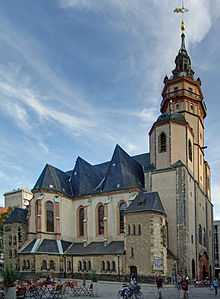Lobe den Herrn, meine Seele, BWV 69
| Lobe den Herrn, meine Seele | |
|---|---|
| BWV 69 | |
| Sacred cantata by J. S. Bach | |
 Nikolaikirche, where the inauguration of a new Leipzig town council was annually performed | |
| Related | BWV 69a |
| Occasion | Ratswechsel |
| Performed | 1748 – Leipzig |
| Movements | 6 |
| Cantata text | anonymous |
| Chorale | by Martin Luther |
| Vocal | SATB choir and solo |
| Instrumental | |
Lobe den Herrn, meine Seele (Praise the Lord, my soul), BWV 69, is a cantata by Johann Sebastian Bach.
History and text
Bach composed a cantata with this title (BWV 69a) in 1723 during his first year in Leipzig. Bach revived the work later in the 1720s, changing the instrumentation of one of the arias. Much later, in 1748, he reworked the cantata for the church service which was held to mark the inauguration of a town council.[1] The recitatives and the chorale were changed. In this form, it was first performed on 26 August 1748.[2] The festive orchestration of the original work was suitable for the new occasion.
The text of the first movement is from Psalm 103. The chorale is the third verse of "Es woll uns Gott genädig sein" by Martin Luther (1524). The author of the rest of the text is unknown.[2]
Scoring and structure
The cantata is scored for four solo voices (soprano, alto, tenor, and bass), a four-part choir, three trumpets, timpani, three oboes, oboe d'amore, bassoon, two violins, viola, and basso continuo.[3]
The work is in six movements:
- Chorus: Lobe den Herrn, meine Seele
- Recitative (soprano): Wie groß ist Gottes Güte doch
- Aria (alto): Meine Seele, auf, erzähle
- Recitative (tenor): Der Herr hat große Ding an uns getan
- Aria (bass): Mein Erlöser und Erhalter
- Chorale: Es danke, Gott, und lobe dich
Music
The chorus and the bass aria are taken without significant alteration from BWV 69a. The second movement is a secco soprano recitative which opens much like in the original version before modulating to G major. The other aria is transposed from the tenor original for the alto voice, and is accompanied by violin and oboe instead of flute and oboe da caccia. The following tenor recitative with string accompaniment is "an example of Bach's highly emotional recitative melodic line at its most mature and expressive", but midway through, it moves into a dissonant and chromatic passage. The closing chorale includes prominent parts for trumpet and drums.[4]
Recordings
- Amsterdam Baroque Orchestra & Choir, Ton Koopman. J.S. Bach: Complete Cantatas Vol. 6. Erato, 1997.
- Gächinger Kantorei/Bach-Collegium Stuttgart, Helmuth Rilling. Die Bachkantate Vol. 67. Hänssler, 1982.
- Holland Boys Choir / Netherlands Bach Collegium, Pieter Jan Leusink. Bach Edition Vol. 9. Brilliant Classics, 1999.
References
- ↑ Bach wrote a number of works for this ceremony. See for example Gott, man lobet dich in der Stille, BWV 120
- ↑ 2.0 2.1 "Cantata BWV 69". bach-cantatas. Retrieved 23 July 2013.
- ↑ "BWV 69". University of Alberta. Retrieved 23 July 2013.
- ↑ Mincham, Julian. "Chapter 84 BWV 69". jsbachcantatas. Retrieved 23 July 2013.
| ||||||||||
|